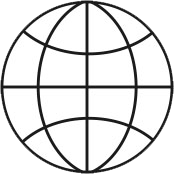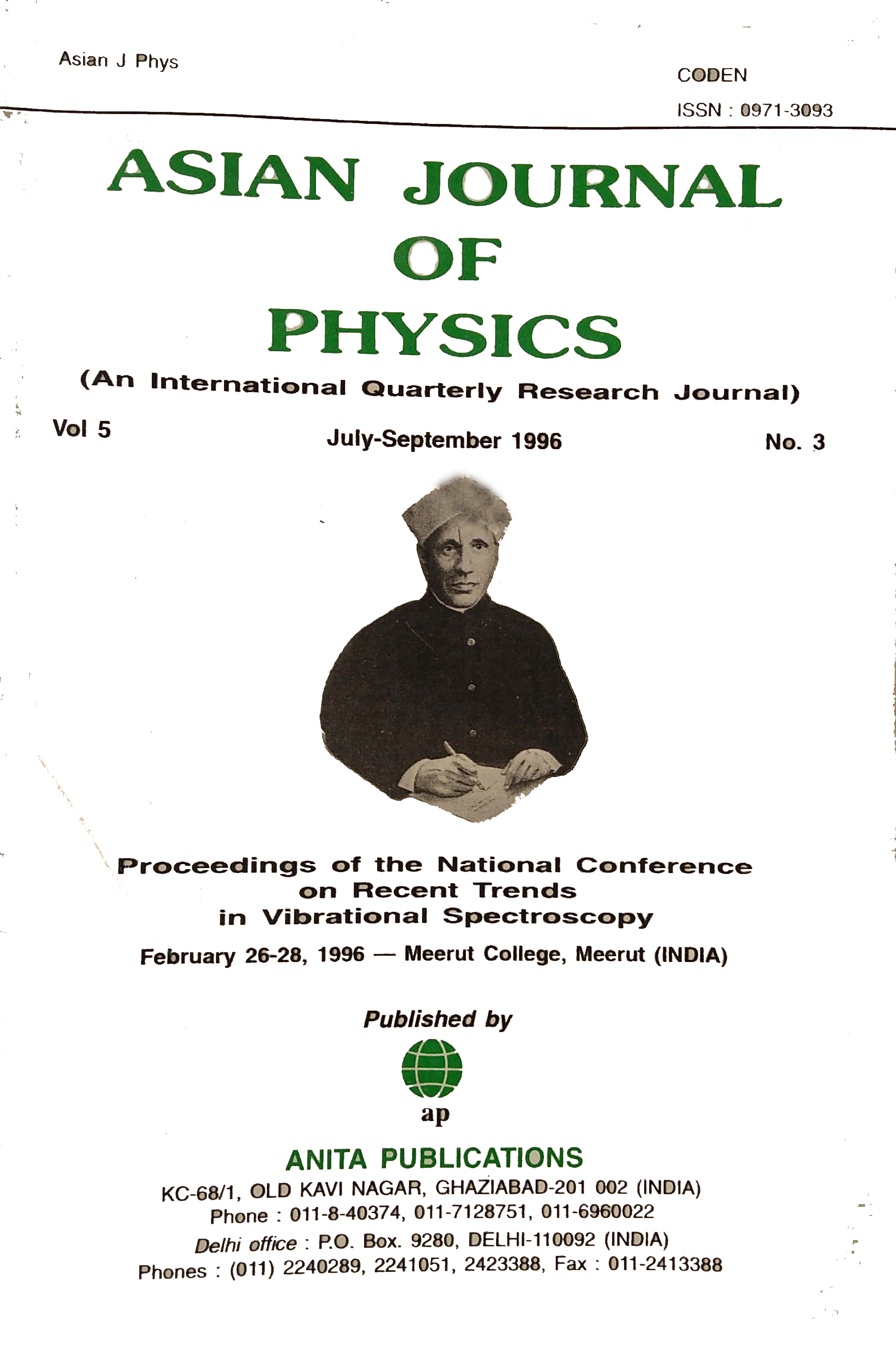
ap

ap
An International Peer Reviewed Research Journal

AJP
SSN : 0971 - 3093
Vol 5, No. 3, July-September, 1996
Vol 5, No 3, 1996
Asian Journal of Physics Vol 5, No 3(1996) 225-229
Direction-cosines for barrier height determination:A general formalism
R Shanker and R A Yadav
Department of Physics
Banaras Hindu University, Varanasi-221 005, India
__________________________________________________________________________________________________________________________________________
In determining barrier height of a top against free rotation, one requires the direction cosines of the top- axis relative to the principal axes. Determination of direction- cosines for a top-axis in a non-planar molecule is not straight-forward. Therefore, a general formalism to determine direction- cosines of a top -axis has been presented for the first time.
References
1. Durig J R, Craven S M & Harris W C, Vibrational Spectra and Structure, Vol 1, Edited by J R Durig,(Marcel Dekker Inc,N Y),1972, p 73
2. Hirschfelder J O. J Chem Phys, 8(1940)431.
3. Colthap N B, Daly L H & Wiberley S E, Introduction to Infrared and Raman Spectroscopy,(Academic Press, N Y and London),1964.
4.Gerald C F, Applied Numerical Analysis, 2nd Edn, (Addison-Wesley Publishing Co, Inc Cambridge, Mass (USA), page 50, (1978)
5.Shanker R , Ph D thesis, Banaras Hindu University, India, 1994.
___________________________________________________________________________________________________________________________________
Asian Journal of Physics Vol 5, No 3(1996) 231-233
Laser Raman and IR spectra of complex of Co(II) with 2-thiouracil
Chander Bala Arora, Rachna Rastogi, Usha Awasthi* and Krishna
Department of Physics
Lajpat Rai College, Sahibabad-201 005, India
*Department of Zoology, Govt Girls College, Rewa, India
___________________________________________________________________________________________________________________________________
Stable complex of Co(II) with 2-thiouracil of the composition [Co(C4H4N2OS)3H2O] has been isolated in the solid state, and characterized on the basis of chemical analysis, magnetic measurement, IR and Raman spectral studies. The spectral studies indicate that the ligand 2-thiouracil acts as monodentate and coordination takes place through sulphur of (C2=S) group.
The ligand and its Co-complex were tested for their activity against Dalton’s lymphoma and it was found that they are effective antitumor agents.
References
1. Rastogi V K, Lal B, Sharma Y C & Jain C L, Metal ions in biology and medicine, (John Libbey, Eurotext, France), 1992, p 184
2.
Rastogi V K, Singh Ajay, Chawla S C & Gupta S L, Procd
5th European Conf on the Spectroscopy of
Biomolecules, (Kluwer Academic Publications,
The
Netherlands),1993,p 203.
3. Rastogi V K, Mital H P & Sharma S N, Indian J Phys B, 64 (1990) 312.
4. Rastogi V K, Lal B, Arora C B & Gupta S L, Procd. IXV International Conf on Raman Spectroscopy, (John Wiley & Sons, N Y)), 1994,p 952.
5. Sathyanarayana D N & Kashmir Raja S V, Spectrochim Acta, A41(1985)809
6. Rastogi V K, Singhal S K, Upadhyay M & Dublish A K, Procd.XV International Conf on Raman Spectroscopy, (John Wiley & Sons), 1996.
___________________________________________________________________________________________________________________________________
Asian Journal of Physics Vol 5, No 3(1996) 235
Thermodynamics of 4-amino-2-chlorobenzonitrile molecule
Sudhir Kumar1 D K Jain2, Sushma Arora1 and Y C Sharma3
1Department of Physics, Lajpat Rai College, Sahibabad-201 005, India
2Department of Physics, Meerut College, Meerut-250 001, Meerut
3Department of Physics, NAS College, Meerut, India
___________________________________________________________________________________________________________________________________
The present note reports the thermodynamical functions viz enthalpy, heat capacity, free energy and entropy of 4-amino-2-chlorobenzonitrile molecule, calculated using vibrational frequencies obtained from IR and Raman spectra of the molecule.
References
1. Sharma Y C, Yadav B S & Pandey A N, Asian J Phys, 3(1993)175.
2. Rastogi V K, Jain D K & Sharma Y C, Asian J Chem, 3(1991)113
3.Hellwege K H & Hellwege A M (Eds), Landolt Barnstein Numerical Data and Fundamental Relationships in Science and Technology New Series: Structural Data for Free Molecules, (Atomic and Molecular Physics), Vol 7, 1976 and Supplement to volume II/7, Vol 15, 1987. Springer Verlag, Berlin, 1976,1987.
___________________________________________________________________________________________________________________________________
Asian Journal of Physics Vol 5, No 3,(1996) 245-246
FTIR and laser Raman spectra of complex of Mn(II) with 2-thiouracil
J K Gupta, Sudhir Kumar, Satyendra Kumar and S D Kaushik*
Department of Physics
L R College (CCS University, Meerut),Sahibabad-201 005, India
Department of Chemistry, L R College, Sahibabad-201 005, India
___________________________________________________________________________________________________________________________________
Metal complexes of Mn(II) with 2-thiouracil of the composition [Mn(C4H4N2OS)3H2O] has been synthesized and characterized on the basis of chemical analysis, magnetic measurement, IR and Raman spectral studies. The spectral studies indicate that the ligand 2-thiouracil acts as monodentate and coordination takes place through sulphur of (C2=S) group. © Anita Publications. All rights reserved.
References
1. Rastogi V K, Mital H P,Sharma S N, Procd. XI International Conf on Raman Spectroscopy, (John Wiley & Sons, N Y), 1988,p 87.
2. Rastogi V K, Mital H P & Sharma S N, Indian J Phys B, 64 (1990) 312.
3. Rastogi V K, Lal B, Arora C B & Gupta S L, Procd. IXV International Conf on Raman Spectroscopy, (John Wiley & Sons, N Y), 1994, p 952.
4.
Rastogi V K, Mital H P, Arora C B, Gupta S L, Proc.
6th European conf on the spectroscopy of
biomolecules,(Kluwer Academic Publications:
The
Netherlands),1995.
5. Arora C B, Rastogi R, Awasthi U, Krishna, Laser Raman and IR spectra of complex of Co(II) with 2-thiouracil, Asian J Phys, 5(1996)231-233
___________________________________________________________________________________________________________________________________
Asian Journal of Physics Vol 5, No 3(1996) 247-248
FTIR and laser Raman spectra of 5-iodourail
Sudhir Kumar, S K Singhal1, J P Goel2 and M Srivastava3
Physics Department, L R College, Sahibabad-201 005, India
1Department of Physics,Agrasain Degree College, Sikandarabad-203 205,India
2Department of Physics, Meerut College, Meerut-250 001, India
3Department of Chemistry, L R College, Sahibabad-201 005, India
___________________________________________________________________________________________________________________________________
FTIR (200-4600 cm-1) and laser Raman(10-2000 cm-1) spectra of 5-iodouracil have been recorded. The spectra have been analysed assuming Cs point group symmetry and the observed fundamentals have been assigned to different normal modes of vibration. ©Anita Publications All rights reserved.
References
1. Sharma V, Sharma S D, Seema,Yada B S, Asian J Phys, 3(194)229.
2. Bandekaar J, Zundel G, Spectrochim Acta, 39A(1983)343.
3. Szezesniak M, Nowak M J, Rostkowska H, Szezesniak K, Person W B, Shugar D, J Am Chem Soc,105(1983)5969.
4. Rastogi V K,Mital H P, Sharma S N, Indian J Phys, 64B(1990)312.
5.
Rastogi V K, Mital H P, Sharma Y C, Sharma S N, Spectroscopy of
Biological Molecules, Eds R E Hester, R B Girling, (Royal Society
of Chemistry),1991, p
403.
6.
Rastogi V K, Lal B, Sharma Y C, Jain C L, Metal ions in Biology and
Medicine, Vol 3, Eds J Anastassopoulou, P Collery, J-C Etienne, Th
Theophanides, (John
Libbey Eurotext, France), 1990, p 184.
___________________________________________________________________________________________________________________________________
Asian Journal of
Physics
Vol. 5,
No 3 (1996) 283-289
Emission and Excitation Studies in Eu2+ and Mn2+ Doped KBr
A K Mishra
Physics Department, NAS College, Meerut- 250 004 , India
and
S D Pandey
cPhysics Department, PPN College, Kanpur- 2008 001, India
___________________________________________________________________________________________________________________________________
The optical emission and excitation spectral studies in KBr: Eu2+ and Mn2+ single crystals at, different sample conditions have been analysed to identify the various aggregates and precipitates of both impurities and possible energy transfer from one impurity to another. The emission obtained at 525 nm in the both grown samples at RT and LNT is proposed to be due to radiative energy transfer from Eu2+ to Mn2+ ions, the latter being in Suzuki phase. The RT emission spectra of the samples annealed for long time at 220 °C and LNT emission spectra of as grown samples identify the growth of different aggregates of Eu2+ and Mn2+ ions at the expense of (I-V) dipoles of the two impurities. © Anita Publications. All rights reserved.
Keywords: KBr, Suzuki phase, Eu2+ and Mn2+ single crystals
Total Refs: 31
___________________________________________________________________________________________________________________________________
1 Introduction
Many investigations have been devoted to divalent impurity doped alkali halide crystals which exhibt intetresting peculiarities due to the presence of a cation vacancy compensating the electrical extra charge of the divalent ion. The resulting (I-V) pairs have been studied by different techniques as optical [1-5], EPR [6], ITC and ionic conductivity studies [8].
Particularly, the optical properties of Eu2+ ions in alkali halides are fairly well understood. The Eu2+ -ions doped in KBr host have two absorption bands [3] in the UV region of the spectrum, with peak positions at 250 nm and 344 nm. These bands are due to dipole allowed transitions from the ground state 8S7/2 of Eu2+ ions to the splitted crystal field 5d orbitals. The high-energy band is due to transitions from the ground statet of the Eg component of the 4 f 6(5d) configuration, while the low energy band is attributed to the T2g component of this configuration. As these transitions are dipole allowed, their oscillator strengths are high making the Eu2+ -doped KBr system an efficient absorber of UV light.
The optical properties [9,10] of Mn2+ ions in alkali
halides are also fairly well understood. The absorption bands of
Mn2+ ions in alkali halides are
relatively weak because these arises from spin and parity forbidden
transitions. The oscillator strength of these transitions is around
10–7, which makes Mn2+
doped systems weak absorbers of UV
light.
© ANITA PUBLICATIONS
All rights reserved
Designed & Maintained by
Manoj
Kumar